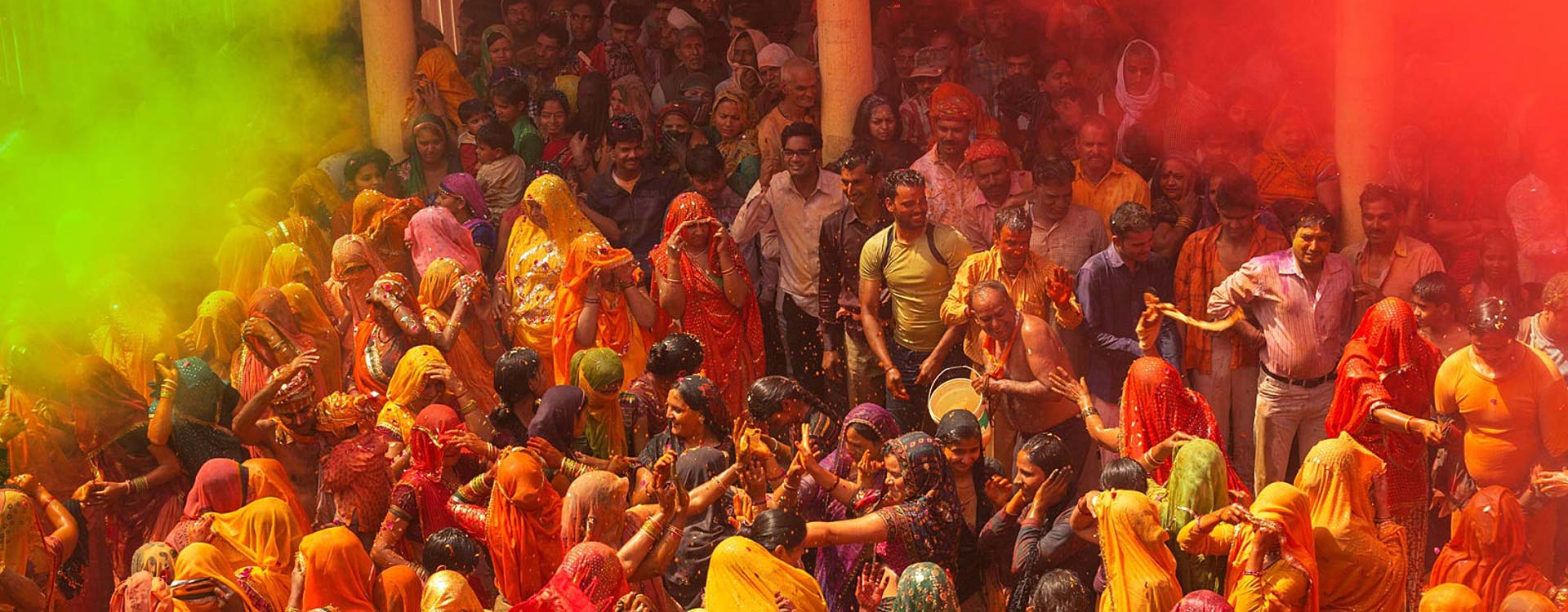Mathura is one of the seven holiest cities of Hindus, the other being Ujjain, Haridwar, Kasi, Kanchi, Puri and Dwaraka. Located on the banks of the river Yamuna, in the present day Uttar Pradesh, Mathura has a long history, a tradition associated with the life of Lord Krishna and the sanctity of a holy place rivaling that of Kasi.
In its long and checkered history of 5000 years, it received the positive and negative attention of many kings and emperors who either built monuments of their own or destroyed those built by others.
History
During the epic period (3000 BC), Mathura was a busy urban settlement ruled by Yadava rulers of great antiquity. Surasena of Yadu dynasty was one such ruler. His kingdom was usurped by Kamsa of Bhoja dynasty. Kamsa was a tyrant and maternal uncle of Lord Krishna. He established powerful alliances with neighboring kings like Jarasandha of Magadha and subjected the yadus to great discrimination. Lord Krishna who grew up in nearby Vrindavan along with his step brother Balarama eventually killed him in an epic encounter to fulfill a divine prophecy and relieved the people from his tyrannical rule.
Lord Krishna was not an original vedic deity. He was a popular divinity in the land of Braj and absorbed into vedic pantheon with the rise of Vaishnavism. From the Bhagavadgita it becomes clear that he made a significant contribution to Hinduism by integrating diverse schools of native thought into the vedic tradition of his time. He established bhakti or devotion of the rural folk or the uneducated humble people as the most important means of salvation in contrast to the karma marg (path of action) of the ambitious urban elite and jnana marg (path of knowledge) of the ascetic forest dwellers.
Not much is known about the city of Mathura during the post Mahabharata period. However as is evident from the Jain and Buddhist texts, the city was a popular learning center in 6th century BC and frequented often by both Vardhamana Mahavira, the last Jain Thirthankara, and Gautama Buddha, the founder of Buddhism. They saw a great potential in the city's educated population to propagate their ideas. During the Mauryan rule, Mathura was a popular trading center and mentioned by both Megasthanese and Arrian.
Between 1st Century BC and 1st Century AD, Mathura became the provincial capital of the northern province of the Saka Satraps such as Hagamasha, Hagana, Sodasa and Rajula. During the reign of the Kushanas, Mathura rose to prominence and gained distinction for a peculiar form of art currently recognized by the historians as the Mathura school of art. Kanishka, the most famous of the Kushana rulers and his successors, ordered the building of several Buddhist monuments, statues and sculpture in the city. If you visit the Mathura museum, you will see several statues and sculpture of the period in display there. While Buddhism and Jainism continued to flourish in and around Mathura for several centuries, Mathura became a strong hold of Brahmanism under the patronage of Hindu rulers such as the Nagas and the Guptas. Fa-Hsien, who visited India during the reign of Chandragupta II (about 400 AD), saw Buddhism flourishing in the city with 20 monasteries and more than 3000 Buddhist monks. He also saw six stupas erected in the honor of some famous Buddhist monks. Two hundred years later, when Hieun Tsiang visited India (630 - 644 A.D.) during the reign of Harshavardhana, Hinduism was flourishing in Mathura while Buddhism continued to maintain its stronghold. Hieun Tsiang noted five large Hindu temples, twenty Buddhist monasteries, about 2000 Buddhist monks and nuns and a good number of Buddhist stupas at Mathura.
Vrindavan
While Mathura, with its narrow and dust laden streets and urban buzz, overwhelms the visitors to the city, Vrindavan, which is situated a few miles from Mathura, offers a more secluded and peaceful experience. Believed to be built on the ancient forest land where Krishna spent his youthful days in the company of cattle, maidens and cowherds, Vrindavan exudes the quietude of the country side and the sanctity of a holy place. In recent times Vaishnava sects such as the Gaudiya Vaishnavism of Chaitanya Mahaprabhu and Radhavallabha sect of Hith Harivams established their ashrams at Vrindavan and made it more popular. Swami Bon Maharaj founded the Vaishnava University while, the followers of ISKCON established their headquarters where visitors can see its Krishna Balarama temple and the samadhi of its founder Swami Bhaktivedanta.
Places to Visit Mathura
The Madan Mohan Temple
Built by Kapur Ram Das of Multan, this is the oldest temple in Vrindavan and associated with the saint Chaitanya Mahaprabhu.
Bankey Bihari Temple
Officially known as Shri Bankey Bihari Mandir, the Bankey Bihari temple of Vrindavan is one of the holiest temples of Lord Krishna in India. Constructed in 1864, the temple houses the idol of Lord Krishna in the form of a child i.e. Nand Gopal.
Gita Mandir
Gita Mandir, also known as Birla Mandir is located on the outskirts of Mathura, on the road connecting Vrindavan and Mathura. The mandir is neat, clean, well maintained, and provides an all- pervading peaceful and devotional atmosphere. It is one of the most popular destinations of Mathura frequented by pilgrims and leisure tourists alike. The presiding deity of the shrine Lord Krishna.
Apart from the idol of Lord Krishna, another attraction, ‘Gita Stambh’, is also known to stun visitors. It signifies the victory of truth over evil, as witnessed in the epic Mahabharata. The temple's architecture juxtaposed with intricate carvings and paintings are worth watching. Entire Bhagavad Gita is inscribed on the temple walls, which in turn adds charm to it.
Some useful information on Gita Mandir that tourists should take care of include: The best time to visit the mandir is during the Holi and Janmashtami festival, it remains open all 7 days of the week, and it can be included in a day's sightseeing of Mathura.
Yamuna River
One of the most sacred rivers of India, Yamuna River begins from Yamunotri. is the river is regarded as been turned pure as it flows from the city of Mathura and Vrindavan. Thousands of devotees take a dip in this holy river to rectify their sins and purify their bodies.
Iskcon Temple
Located at Bhaktivedanta Swami Marg, Raman Reiti, Vrindavan, ISKCON temple is popularly known as Sri Sri Krishna Balaram Mandir. One of the most magnificent temples of Vrindavan, it was inaugurated by A. C. Bhaktivedanta Swami Srila Prabhupada, Founder Acharya of the International Society for Krishna Consciousness on Ram Navami Day (20 April, 1975). He also installed beautiful idols of Sri Sri Krishna Balaram, Sri Sri Radha Shyamasundar, Sri Sri Gaura Nitai and Lalita Devi & Vishakha Devi in the temple.
ISKCON Vrindavan follows extremely high standard of deity worship that includes:the deities are worshipped by 24 brahmanically trained pujaris.the deities are offered 6 Aratisand 6 Bogaofferings everyday.the dresses of deities are changed twice a day (morning & evening).Some other places worth exploring inside the temple complex includes Goshala, Srila Prabhupada’s Samadhi, Srila Prabhupada’s House, Maha Prasadam Stall, Vrinda Kunda, Gupta Kunda and Bhaktivedanta Book Trust Museum. Another added attraction is the grand celebration of many festivals related to Lord Krishna like Purnima, Janmashtami, Ram Navami, Govardhan Puja, Balaram Purnima and Radhastami.Pointers that would help you chalk a hassle-free trip to the temple are:Various guest houses are available in and around the temple.
The temple is open daily from 10 a.m. to 1 p.m. and 4 p.m. to 8:30 p.m.Krishna Balarama Internet Center is located next to Srila Prabhupada's samadhi which offers high speed Internet access at Rs. 30/hour.You can enjoy delicious pure vegetarian food in the in-house New Govinda’s Vegetarian Restaurant.
Sri Krishna Janmabhoomi Complex
This complex is a massive and magnificent architecture that speaks volumes about the tradition and culture of India. The Krishna Janambhoomi temple is an important site in the religious history of the Hindus as the temple allegedly stands on the exact site where Lord Krishna was born. The pieces of history recovered from the complex are on display for the public in the museum that is located nearby. Apart from the Krishna temple, there are shrines of other Gods and Goddesses in the Krishna Janambhoomi premises. This place is regarded as an important site of adulation for the people of Hindu faith. As the temple shares a common wall with the adjoining Jama Masjid, the pilgrims coming to offer prayer have to go through strict security vigilance.
Shahji Temple
Shahji Temple is one of the famous temples in Vrindavan, devoted to Lord Krishna. The temple possesses a Dravidian architectural style and fabulous marble sculptures which fascinates large number of tourists from all over the world. It was made by Shah Kundan Lal, a prosperous jeweler of Lucknow. The idol of Lord Krishna is known by the name of Chhote Radha Raman.
Kesi Ghat
Kesi Ghat in Vrindavan, Mathura, is one of the most visited places in the area and frequented by devotees and tourists alike. The Ghat, considered to be amongst the best of its in the country, is situated on the banks of the river Yamuna and is a huge hit amongst devotees of Lord Krishna.
According to popular beliefs, this is the Ghat where Lord Krishna took a bath after killing the demon Kesi. Since then, devotees rush in huge numbers to seek blessings of the Lord. An elaborate Aarti is practised every evening, as a ritual for Yamuna Devi. The Ghat is rich in scenic beauty and is a must visit when in the area.
The Jaipur Temple
Built by Sawai Madho Singh II of Jaipur in 1917, the temple is dedicated to Shri Radha Madhava.
The Govind Deo Temple
Built in 1590 by Akbar's general Raja Man Singh, the temple was destroyed by Aurangzeb.
The Sri Krishna-Balrama Temple
Built by the ISKCON, it houses the images of Krishna & Balaram, in the company of Radha-Shyamasundar and Gaura-Nitai. The samadhi of A. C. Bhaktivedanta Swami Prabhupada, the founder of ISKCON, is located nearby.
The Radha Damodar Mandir
Established in 1542 by Srila Jiva Goswami, it houses the deities Radha and Damodar. The bhajan kutir of A. C. Bhaktivedanta Swami Prabhupada is also located here.
How to Reach Mathura
Mathura does not have its own airport but it’s close enough to Delhi and Agra so tourists can visit the town by flying to either of these cities. The Agra Airport is a domestic airport with flights connecting it to Goa, Mumbai, Bangalore and more. The airlines that operate here are JetLIte, Air India, etc. For international flights and flights to and from other cities, the Delhi airport can be used. The Indira Gandhi International Airport connects to city to global cities like Toronto, Dubai, Seoul, Rome, Tokyo, etc. It is served by all the major Indian and international airlines such as GoAir, IndiGo, Emirates, Cathay Pacific, British Airways, Lufthansa, etc.
By Nearest Airport
The closest international airport to Mathura is Delhi airport which is 147km away and the nearest domestic airport is Kheria airport, Agra, just 49km away. Taxis are available from both these airports.
By Rail
Mathura Junction is a major railhead on Central and Western Railways. Therefore visitors can avail train services from major cities including Kolkata, Delhi, Mumnbai, Indore, Agra, Bhopal, Gwalior, Varanasi, Lucknow to Mathura. One can also board local trains from Delhi, Bharatpur, Alwar and Agra till three other railway stations of Mathura.
By Road
A good network of roadways connect Mathura to Delhi, Agra, Moradabad, Jaipur, Bikaner, Kolkata along with other small towns of UP and nearby states. Mathura is served by several state government buses along with private operators. Visitors can avail direct buses from places like Delhi, Agra, Alwar, Aligarh, Indore, Bhopal, Gwalior, Jabalpur, Jaipur, Udaipur, Ajmer, Chandigarh, Lucknow, Kanpur, Meerut, Haridwar etc.
Best Time to Visit Mathura
The best time to visit the city of Mathura is anytime after the summer. From March to June the city is very hot, and the temperature sometimes reaches as high as 45°C. The monsoon starts in July when the city cools down, and there are just scanty showers. The winters are pleasant with lower temperatures and breezy nights. The winters are the best time to visit the city. The monsoons are also pleasant as the rainfall is not too continuous or heavy.
Mathura Weather
The weather of Mathura is similar to that of most cities in North India. The summers (March to June) get very hot with temperatures soaring to as high as 45°C. Sightseeing becomes very difficult during this season. The monsoons (July to September) brings light showers and cool winds that make going out quite pleasurable. This is followed by the winter season (December to February) which is characterized by cool nights and pleasant days. The temperature ranges from as high as 32°C during the day and drops to 14°C (and below) on cold nights.






